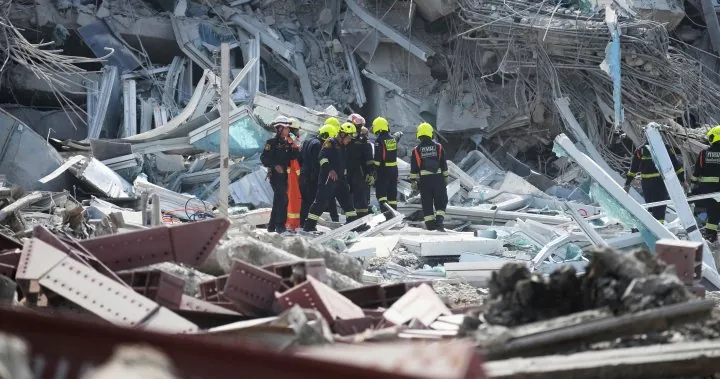
Catastrophic 7.7 Magnitude Earthquake Strikes Myanmar and Thailand, Leaving Over 150 Dead
2025-03-28
Author: William
Overview
A devastating 7.7 magnitude earthquake struck central Myanmar and parts of neighboring Thailand on Friday, leading to widespread destruction and loss of life. The quake's epicenter was located near Mandalay, Myanmar’s second-largest city, and it occurred at midday, triggering a powerful 6.4 magnitude aftershock shortly thereafter.
Death Toll and Humanitarian Crisis
The death toll currently stands at over 150, with reports indicating at least 144 fatalities from Myanmar alone, where many regions are already mired in humanitarian crises due to ongoing civil unrest. In Thailand, the capital Bangkok reported at least eight deaths, primarily from a high-rise building collapse that sent debris plummeting to the ground.
Destruction and Eyewitness Accounts
Images emerging from various parts of Myanmar portray staggering damage, particularly in the cities of Mandalay and Naypyidaw. Eyewitness accounts detail scenes of chaos as rescue teams sift through the rubble, searching for survivors amid crumbled buildings, damaged bridges, and a breached dam that has caused flooding in the low-lying areas.
Emergency Response
“Blood donations are urgently needed in the most affected areas,” officials stated, as countless injured individuals filled hospitals and makeshift medical facilities, emphasizing the dire state of emergency unfolding in one of the world's poorest nations. The military-controlled government has acknowledged approximately 730 injuries but warns that these figures are expected to rise in the coming days as the full impact of the disaster is assessed.
Impact in Thailand
In Bangkok, onlookers watched in horror as the 33-story construction site of a building collapsed near the vibrant Chatuchak market, signifying the quake's reach even in urbanized settings. Panic spread through the city as sirens blared, and residents evacuated high-rise buildings, congesting streets and public transit systems.
Survivors' Experiences
Survivors in Bangkok described feelings of disbelief and chaos as they witnessed the ground shaking and buildings swaying. “I thought I was just dizzy at first,” April Kanichawanakul, an office worker, reflected. Many fled to open spaces like Benjasiri Park, seeking safety away from the fast-rising panic.
Geological Insights
International observers, including the U.S. Geological Survey, indicated that the quake was relatively shallow at 10 kilometers (6.2 miles) deep, a factor known to enhance structural damage.
Rescue Operation Challenges
Further complicating rescue operations, downed power lines and damaged infrastructure are creating significant obstacles for emergency crews. Many areas remain inaccessible, as Myanmar's ongoing civil conflict means that resources and information are scant. The Red Cross has highlighted the difficulty of reaching afflicted regions where millions are already displaced or in need of urgent assistance.
State of Emergency
Myanmar’s military government has declared a state of emergency across six affected regions, including Naypyidaw and Mandalay. However, clarity around these measures remains murky due to the ongoing unrest that has destabilized the country since February 2021.
Cross-Border Impact
Reports also indicate that the tremors were felt across border regions, reaching Yunnan and Sichuan provinces in China, where damage and injuries were reported in border towns like Ruili. Local authorities have begun assessing the damage as residents gather to support one another amidst the unfolding crises.
Conclusion
As the region begins to reckon with the aftermath of this tragic event, aid and support from international organizations will be crucial in providing relief to those in desperate need. The human and economic toll continues to escalate, leaving a country already enduring immense hardship facing yet another monumental challenge.









 Brasil (PT)
Brasil (PT)
 Canada (EN)
Canada (EN)
 Chile (ES)
Chile (ES)
 Česko (CS)
Česko (CS)
 대한민국 (KO)
대한민국 (KO)
 España (ES)
España (ES)
 France (FR)
France (FR)
 Hong Kong (EN)
Hong Kong (EN)
 Italia (IT)
Italia (IT)
 日本 (JA)
日本 (JA)
 Magyarország (HU)
Magyarország (HU)
 Norge (NO)
Norge (NO)
 Polska (PL)
Polska (PL)
 Schweiz (DE)
Schweiz (DE)
 Singapore (EN)
Singapore (EN)
 Sverige (SV)
Sverige (SV)
 Suomi (FI)
Suomi (FI)
 Türkiye (TR)
Türkiye (TR)
 الإمارات العربية المتحدة (AR)
الإمارات العربية المتحدة (AR)